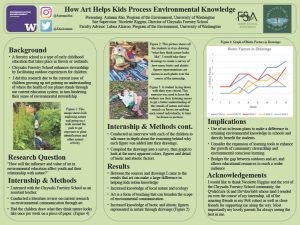How Art Helps Kids Process Environmental Knowledge
My research project was focused on environmental education, a way to connect to future generations and create a framework for teaching methods. New practices are still being established within community efforts and educational data to support effective and meaningful learning strategies. This research seeks to understand how forestry schools as educational spaces can help students understand the environment more deeply through the use of data analysis. In order to answer this question, I made an annotated bibliography for 10 sources related to environmental education, forestry school, and using art as a teaching method. My internship was working with the Chrysalis Forestry School as an assistant teacher. I would collect data regarding if art can make a difference in supporting children to digest environmental knowledge. I did this research due to the current issue of children growing up not gaining an understanding of where the health of our planet stands through our current education system, in turn hindering their sense of environmental stewardship. My study had the forestry students draw what they think nature looks like throughout the internship. I took those drawings and analyzed the biotic and abiotic properties into a survey. In the survey over the internship I saw an increase in details and biotic figures, showcasing the importance of living figures to create a healthy biodiverse environment. Between the sources and drawings I came to the results showing that art can make a large difference in helping kids retain knowledge. Art is a form of teaching that can broaden the scope of environmental communication that I found through this research of teaching environmental ethics to children. Along with all sustainable resource management through a mixed methods approach of art along with an analytical method of surveys. This together gave me the most effective summary of the research that looked into the scale of environmental consciousness the students had when drawing their art and looking at the patterns of changes throughout the course length. These findings of this research are primarily meant for Chrysalis Forestry School, an outdoor school that can use the implications of art to make a difference in retaining environmental knowledge in schools and directly benefit the students.
